Change in Material Per Turn

This chart is based on a single playout, and gives a feel for the change in material over the course of a game.
Go with the addition of neutral Henge pieces.
GoRoGo is new Go variant game for two players played with each 10 ordinary black and white pieces and 5 additional neutral ones. Each player has two of the neutral pieces, and one starts on the game board.
Like Go, the game is played on a grid, but the board has only a 5x5 grid with 25 intersections and 40 paths. The purpose of the game is to obtain more of your opponent's pieces, not to claim an area majority.
Since there are only 25 pieces, the game is over after 24 moves at most. A player cannot pass, nor play a neutral piece last. If they don't have a legal move, they lose.
The neutral pieces are both black and white. That is, on Black's turn, a neutral piece is a black piece. Then on White's turn, it is a white piece. This allows moves that are normally prohibited in Go, such as 'Kou'. A player can attack into an area that in Go would be protected.
GoRoGo is a GO game but not GO. It means that the tactics are GO tactics but the strategy isn't GO.
General comments:
Play: Combinatorial
Family: Combinatorial 2016
Mechanism(s): Capture,Territory
Components: Board
| BGG Entry | GoRoGo |
|---|---|
| BGG Rating | 6.65 |
| #Voters | 10 |
| SD | 1.37931 |
| BGG Weight | 0 |
| #Voters | 0 |
| Year | 2016 |
| User | Rating | Comment |
|---|---|---|
| zeder | 5 | |
| hippiephysicschick | N/A | Ks 2p abstract |
| psychomansam | 7 | |
| mrraow | 7 | The neutral stones really do change the nature of the game, making it feel very different from go, and interesting on a small board; nonetheless, I suspect it has limited replay value. |
| Kaffedrake | 4 | A small claustrophobic tactical Go variant with neutral pieces. There are worse Go variants with neutral pieces. |
| Geeken | N/A | 5.8KS 2020 |
| nycavri | 7 | |
| fogus | 5.5 | |
| blakstar | 8 | |
| AmadanNaBriona | N/A | Kickstarted. |
| bigglesbee | 7 | |
| lizlam | 9 | A fun and simple Go variant. |
| dwskoog | N/A | Numbered and signed mini board |
| Jeff_Ten | 7 |
| AI | Strong Wins | Draws | Strong Losses | #Games | Strong Win% | p1 Win% | Game Length |
|---|---|---|---|---|---|---|---|
| Random | |||||||
| Grand Unified UCT(U1-T,rSel=s, exp=0.70, secs=0.01) | 36 | 0 | 0 | 36 | 100.00 | 55.56 | 25.00 |
| Grand Unified UCT(U1-T,rSel=s, exp=0.70, secs=0.03) | 36 | 1 | 9 | 46 | 79.35 | 46.74 | 25.00 |
| Grand Unified UCT(U1-T,rSel=s, exp=0.70, secs=0.55) | 35 | 2 | 2 | 39 | 92.31 | 46.15 | 25.00 |
Level of Play: Strong beats Weak 60% of the time (lower bound with 90% confidence).
Draw%, p1 win% and game length may give some indication of trends as AI strength increases; but be aware that the AI can introduce bias due to horizon effects, poor heuristics, etc.
| Size (bytes) | 24156 |
|---|---|
| Reference Size | 10577 |
| Ratio | 2.28 |
Ai Ai calculates the size of the implementation, and compares it to the Ai Ai implementation of the simplest possible game (which just fills the board). Note that this estimate may include some graphics and heuristics code as well as the game logic. See the wikipedia entry for more details.
| Playouts per second | 61418.65 (16.28µs/playout) |
|---|---|
| Reference Size | 519049.10 (1.93µs/playout) |
| Ratio (low is good) | 8.45 |
Tavener complexity: the heat generated by playing every possible instance of a game with a perfectly efficient programme. Since this is not possible to calculate, Ai Ai calculates the number of random playouts per second and compares it to the fastest non-trivial Ai Ai game (Connect 4). This ratio gives a practical indication of how complex the game is. Combine this with the computational state space, and you can get an idea of how strong the default (MCTS-based) AI will be.
| 1: White win % | 39.58±2.49 | Includes draws = 50% |
|---|---|---|
| 2: Black win % | 60.42±2.55 | Includes draws = 50% |
| Draw % | 10.73 | Percentage of games where all players draw. |
| Decisive % | 89.27 | Percentage of games with a single winner. |
| Samples | 1444 | Quantity of logged games played |
Note: that win/loss statistics may vary depending on thinking time (horizon effect, etc.), bad heuristics, bugs, and other factors, so should be taken with a pinch of salt. (Given perfect play, any game of pure skill will always end in the same result.)
Note: Ai Ai differentiates between states where all players draw or win or lose; this is mostly to support cooperative games.
Rotation (Half turn) lost each game as expected.
Reflection (X axis) lost each game as expected.
Reflection (Y axis) lost each game as expected.
Copy last move lost each game as expected.
Mirroring strategies attempt to copy the previous move. On first move, they will attempt to play in the centre. If neither of these are possible, they will pick a random move. Each entry represents a different form of copying; direct copy, reflection in either the X or Y axis, half-turn rotation.
| Game length | 25.00 | |
|---|---|---|
| Branching factor | 21.83 | |
| Complexity | 10^30.76 | Based on game length and branching factor |
| Samples | 1444 | Quantity of logged games played |
| Distinct actions | 51 | Number of distinct moves (e.g. "e4") regardless of position in game tree |
|---|---|---|
| Good moves | 23 | A good move is selected by the AI more than the average |
| Bad moves | 27 | A bad move is selected by the AI less than the average |
| Samples | 1444 | Quantity of logged games played |

This chart is based on a single playout, and gives a feel for the change in material over the course of a game.

This chart shows the best move value with respect to the active player; the orange line represents the value of doing nothing (null move).
The lead changed on 8% of the game turns. Ai Ai found 0 critical turns (turns with only one good option).
Overall, this playout was 68.00% hot.

This chart shows the relative temperature of all moves each turn. Colour range: black (worst), red, orange(even), yellow, white(best).

Table: branching factor per turn.

This chart is based on a single playout, and gives a feel for the types of moves available over the course of a game.
Red: removal, Black: move, Blue: Add, Grey: pass, Purple: swap sides, Brown: other.
| 0 | 1 | 2 | 3 | 4 |
|---|---|---|---|---|
| 1 | 25 | 1225 | 56425 | 2485257 |
Note: most games do not take board rotation and reflection into consideration.
Multi-part turns could be treated as the same or different depth depending on the implementation.
Counts to depth N include all moves reachable at lower depths.
Zobrist hashes are not available for this game, so transpositions are included in the counts.
No solutions found to depth 4.
| Moves | Animation |
|---|---|
| Ha1 | 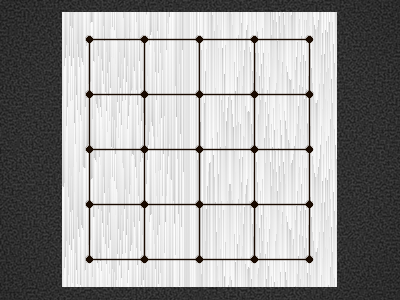 |
| Hb1 | 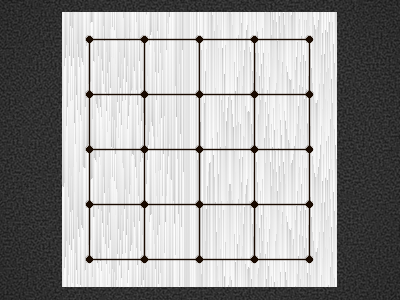 |
| Hc1 | 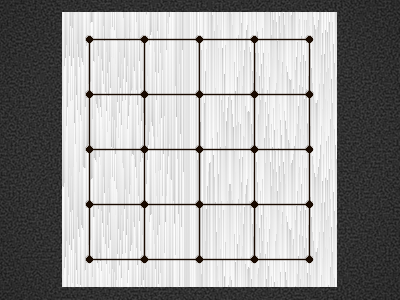 |
| Hd1 | 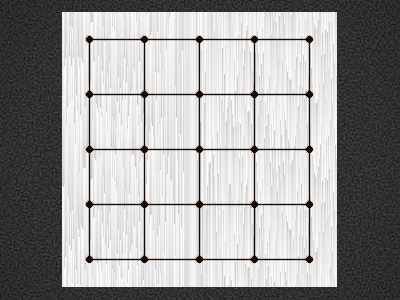 |
| He1 | 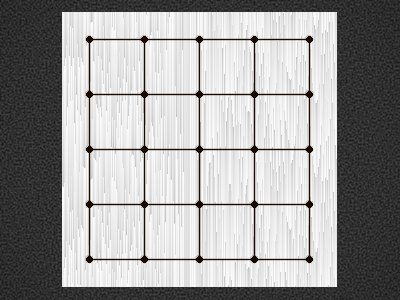 |
| Ha2 |  |
| Hb2 | 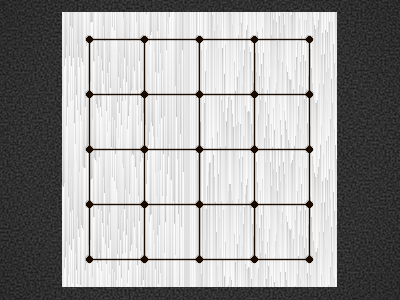 |
| Hc2 | 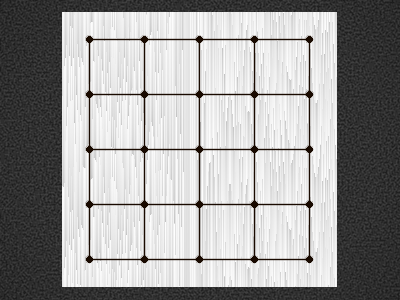 |
| Hd2 | 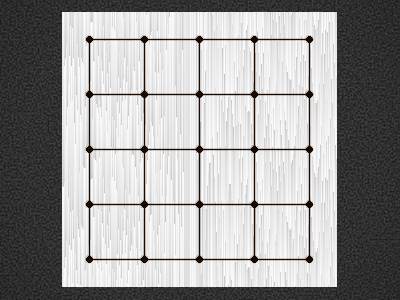 |
| He2 | 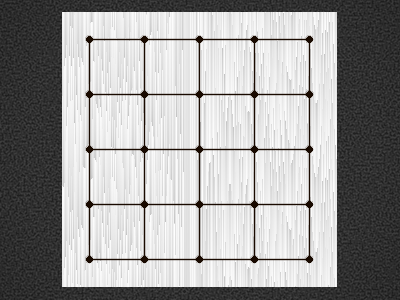 |
| Ha3 | 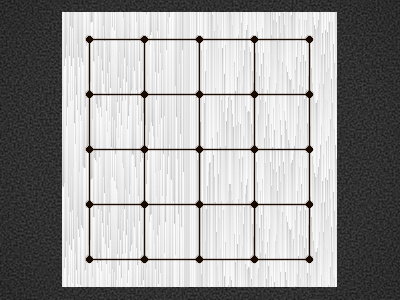 |
| Hb3 | 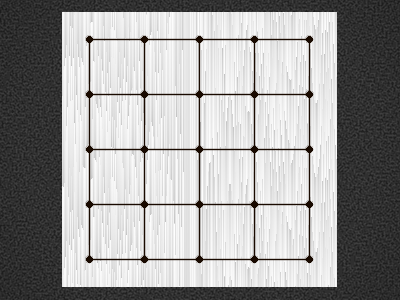 |
| Puzzle | Solution |
|---|---|
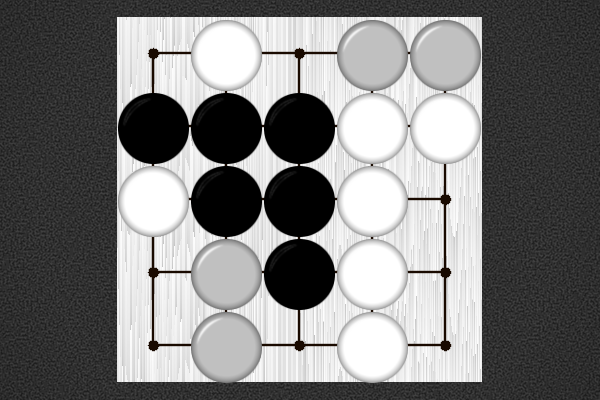 Black to win in 8 moves | |
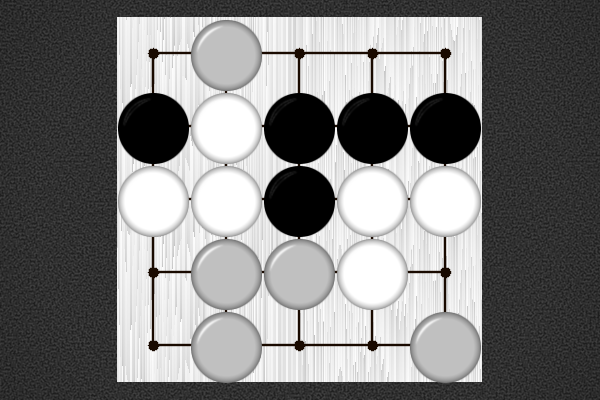 White to win in 7 moves | |
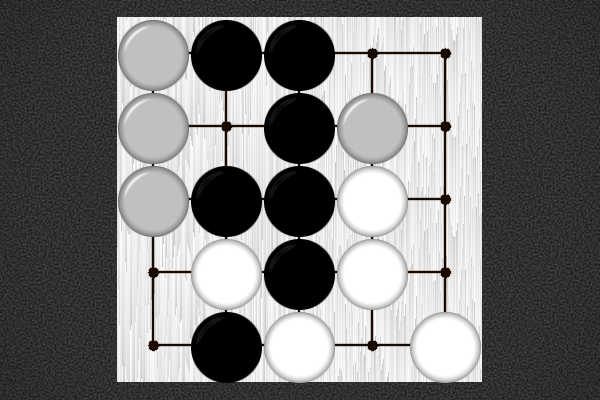 White to win in 5 moves | |
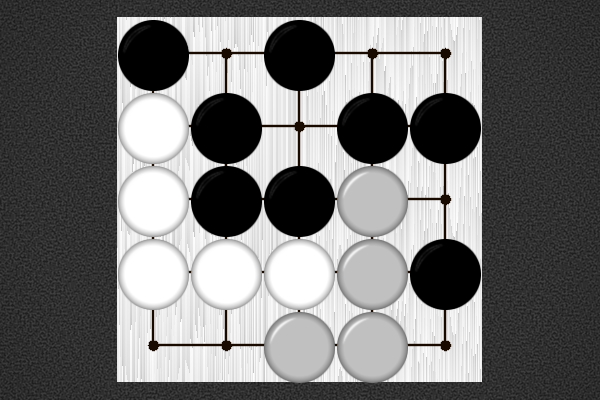 White to win in 5 moves | |
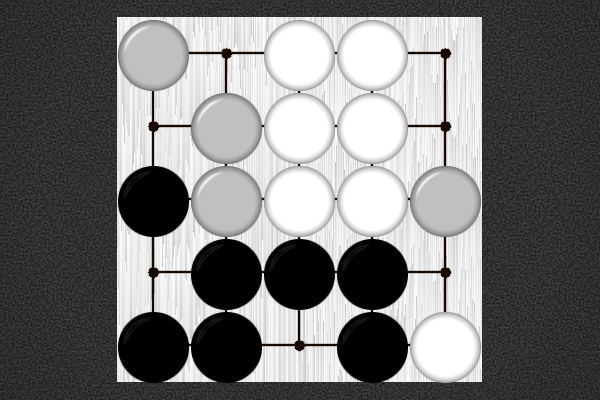 White to win in 5 moves | |
 White to win in 5 moves | |
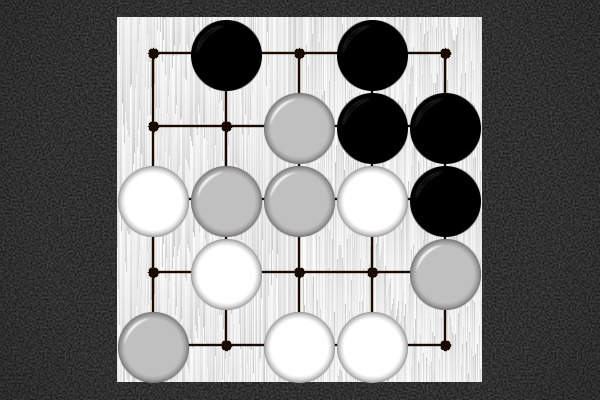 Black to win in 4 moves | |
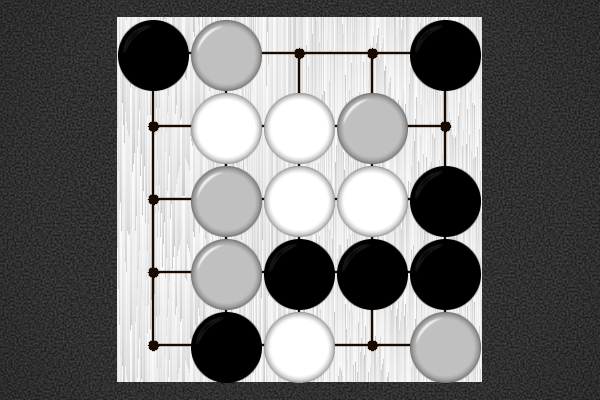 White to win in 7 moves | |
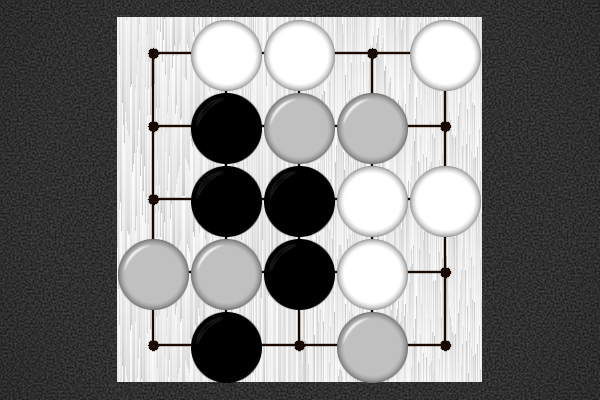 White to win in 7 moves | |
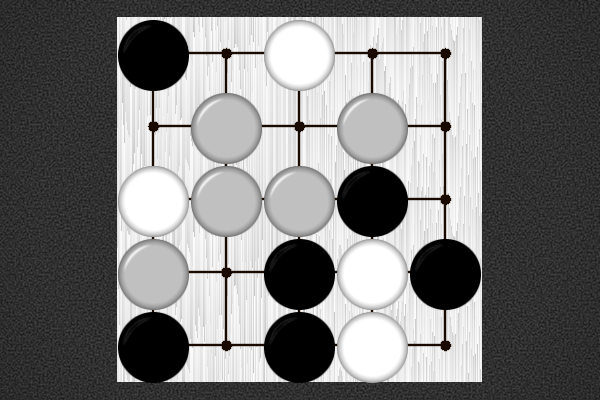 White to win in 5 moves | |
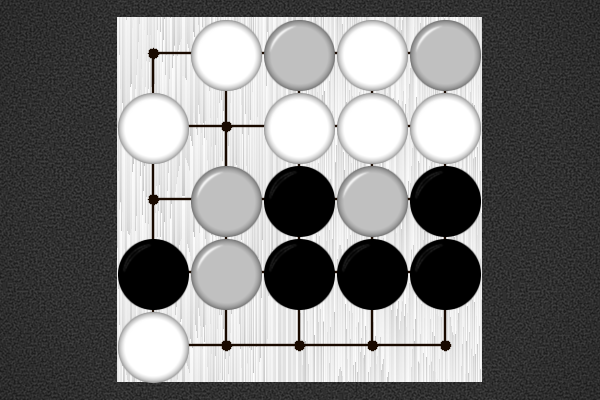 White to win in 5 moves | |
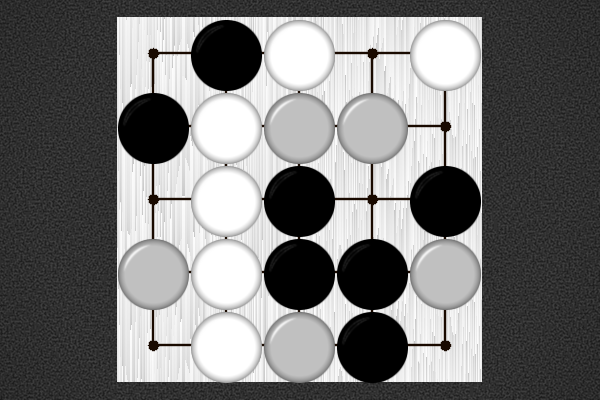 Black to win in 6 moves |
Selection criteria: first move must be unique, and not forced to avoid losing. Beyond that, Puzzles will be rated by the product of [total move]/[best moves] at each step, and the best puzzles selected.